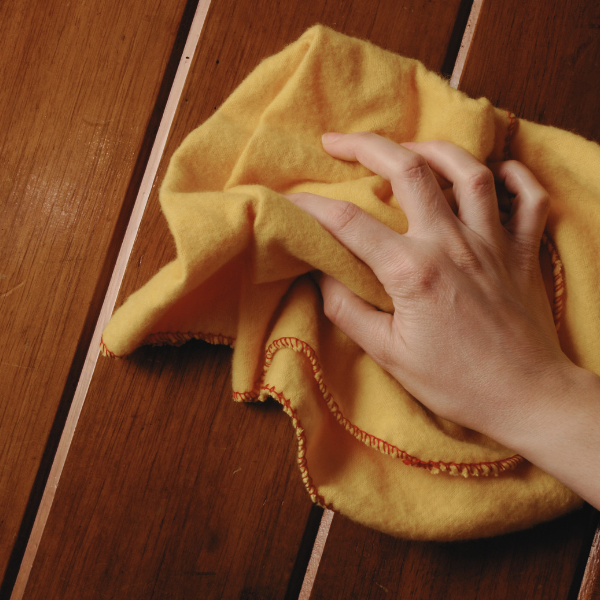
Have a handmade oak bench? A wooden mantelpiece? With good care and maintenance, your oak furniture will last for generations to come. Here is our complete guide on how to clean and maintain your wood furniture the right way.
How to Clean Wood Furniture
If you’ve not forgotten to wax or use timber treatment oil, then there’s no need for any harsh cleaning products. The wax forms a protective layer against dust and dirt and light liquid splashes, so all you need to do is wipe your furniture down with a damp cloth.
Wooden worktops in the kitchen should be cleaned with a gentle disinfectant, and there’s not much better for that than warm soapy water. Kitchen worktop cleaners can damage the protective oiled/waxed layer if they’re not made specifically for wooden surfaces.
Removing Scratches and Stains From Wood Furniture
If you’ve spilled red wine on your oak bench, or used a knife a little too liberally, you might think you just have to live with your new decorative marks. Fortunately, you can sand the table surface until the mark is gone, then refinish the surface.
Oak is a very strong and durable material that can be sanded down to refresh its appearance whenever anything happens. That’s what puts it a cut above other types of furniture that use composite materials or chipboard.
It’s important to keep your sanding even, and not focused solely on the problem area, or you might create a very obvious depression in the wood. You can always ask for help from a professional woodworker if you’re not confident to do it yourself.
How to Maintain Oak Furniture
You will need to treat your timber once every six months to maintain its protective seal and keep it from cracking. Wood treatment oils and waxes protect the grain of the wood and make it resistant to water and a number of other conditions.
All oak furniture for sale should state whether it has been treated or not before being sent to you. Most outdoor oak furniture will be pre-treated with a weatherproof oil, and most indoor oak furniture is supplied unoiled. Be sure to read the product description or ask if you’re unsure.
If you’ve bought stained oak furniture, then it’s best to use timber treatment oil that matches the finish. If you’re unsure, test the oil in an unseen area first to see if you’re happy with the dried look. To apply a treatment oil:
- Clean the furniture thoroughly to remove dust and dirt.
- Use a lint-free cloth to apply the oil in a circular motion evenly across a surface.
- Keep applying the oil until the wood stops absorbing it.
- Remove all excess oil with a clean cloth and leave to dry.
- Apply additional coats for older or well-used furniture.
For food preparation surfaces, a natural food-safe wax is what you will want to use. Some waxes can stain, so test in an unseen area if you are unsure. To apply wax:
- Apply a little wax onto a lint-free cloth and rub across the wooden surface.
- Leave to soak in.
- Buff off to leave a smooth, water-resistant finish.
- Repeat as required on older or well-used surfaces.
At Celtic Timber we don’t just have oak furniture for sale, we have a range of timber treatment oils, protective oils, and food-safe waxes to help you maintain your oak furniture and worktops. Check out our range on our website whenever you’re running low.
Fiddes High Build Exterior Wood Protective Oil
Can Mould Grow on Wood Furniture?
Mould is a fungus and will grow and feed on wood when it has excessive moisture. This is most often caused by floods, rising damp, or poorly ventilated rooms. If left untreated, it will penetrate deep into the wood, compromising its strength and durability.
You’ll know if your wooden furniture has mould through the following signs:
- Black, green, or white spots growing on the surface
- Musty odour
- dark/green discolouration of the wood
- If the wood is soft and spongy, it means significant damage has occurred, and you may need to dispose of the furniture piece.
How to Get Rid of Mould on Wood Furniture
Undiluted white vinegar can be poured or sprayed on the affected areas. This method is best for treating very light mould infestations on stained wood, where mould and moisture has not penetrated deep into the wood.
For heavier mould infestations, hydrogen peroxide, bleach, or a commercial mould remover can be used. Be aware these treatments can discolour the wood, and you may want to sand or paint over to hide this.
You’ll want to address the cause of the damp issue first, or move the furniture to a safer location, otherwise the mould will keep coming back. Once the mould is gone, you can sand to remove stains or paint over it A dehumidifier can be used to force-dry the surface of the wood and reduce ideal conditions for mould growth, but does not directly kill mould.
